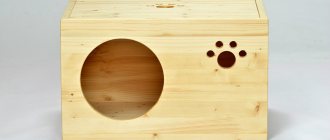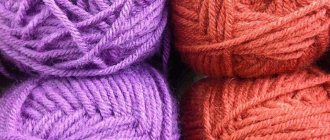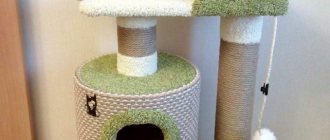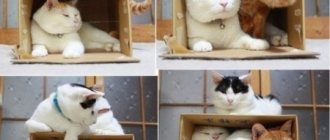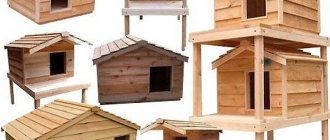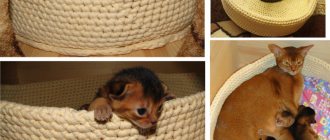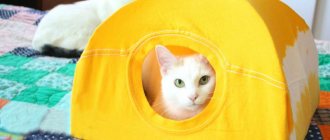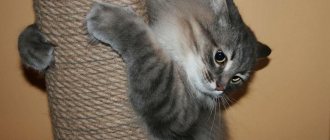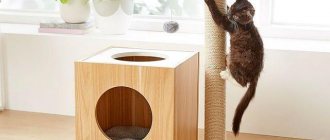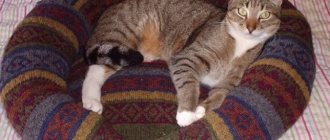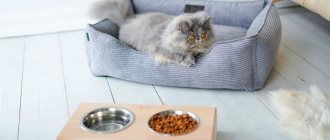Photo: musely.com All animals need their own personal living space, so it is imperative to take care of arranging their own corner for them. And your favorite Barsik or Ryzhik is no exception here either! We have collected 11 great ways to make a cat house with your own hands from available materials. Watch and get inspired!
We live out of suitcases
Of course, this formulation does not sound very good, but as far as building a house for a cat is concerned, it is quite possible.
Moreover, if you do a little tinkering, you can place not one, but even two cats here. In its structure, such a design will resemble a children's bunk bed.
To create it, you need to divide an old suitcase into two halves and insert supports between them (their role can easily be played by the legs from an old stool). Next, we set up a warm bed. Voila, the “apartments” are ready!
Photo: hillspet.ru Photo: magnat-home.ru
Requirements
There are several basic requirements for cat fences.
- The enclosing structure must be functional, and its dimensions must be comparable to the number of furry pets.
- It is advisable to equip any outdoor structure with an awning or a waterproof roof. This will not only protect the cat from the rain, but will also prevent the agile animal from jumping over the walls of the enclosure.
- Another detail necessary for an outdoor enclosure is gutters, otherwise, after rain, water will begin to accumulate on the floor of the structure, which will significantly worsen the pet’s living conditions.
- The design of the floor of the enclosures can be very monotonous. Most often, tiles or linoleum are used; in some cases, plank floors are installed, and some areas are decorated with artificial turf. It is extremely important that there are not too large gaps between the bottom and the side walls, as this could cause the cat to get out and run away.
- When choosing material for walls, you should first of all proceed from the conditions in which you plan to install the enclosure. Street structures, as a rule, are fenced with chain-link mesh, and apartment fixtures are blocked with thick fabric. The use of glass materials is prohibited.
- It is better to place outdoor structures in dimly lit areas protected from drafts. Exposure to direct ultraviolet rays is equally dangerous for both the hairless Sphynx and the long-haired Maine Coon.
- If the enclosure is being set up for indoor use to keep newborn kittens, it is important to create all the conditions for the cat’s unhindered access to children. And at the same time, the freedom of young animals should be limited - here the installation of a window or a special damper is optimal.
- Any enclosure, regardless of size, must be equipped with drinking bowls, a cup for food, and a tray with filler. If the pet is in short-term foster care, then the role of a tray can be played by a disposable diaper.
- To make the animal’s stay as comfortable as possible, it is advisable to equip enclosures with houses and all kinds of play complexes.
- Even being in an enclosure cannot protect an animal from diseases, so such pets, like all others, need timely vaccinations, treatment against helminths, ticks, and fleas.
- As for the Voltaire form, there are no restrictions. This could be a walking trail, a multi-level recreation area, a games room and much more.
"Lyuli-Luli"
Many young mothers know how much cats love to huddle in strollers and cribs. And this is not without reason - because it is very warm and cozy there. In addition, our four-legged meowing friends always feel positive energy.
If your child is already older, use a stroller basket or crib to create a cat house. Believe me, your pet will definitely like these apartments!
Now it will be possible to designate the new “owner” of the home with a unique decor, for example, embroidering a nickname or other identification mark on the hood.
Photo: pinterest.de
Features of arrangement and design. What should you pay attention to?
A good home for your pet is designed in accordance with the character of the furry owner, so take a closer look at his habits and lifestyle.
Active animals will appreciate the play component of the house. Organizing a place to play will help channel the cat’s energy into a peaceful direction.
If your cat is a lazy homebody, he will like a large sleeping place. Make it as convenient as possible.
Many animals sharpen their claws in any convenient place, which greatly upsets their owners. By placing a scratching post in your cat's house, you can forget about this trouble.
Cardboard box house
It's no secret that all cats love to hide in boxes. You can make an excellent home for your pet using cardboard packaging from appliances.
Fold the house according to the diagram, using tape and odorless glue to attach the parts. Now you need to cut out the doors, and, if desired, the windows. Inside, place any insulating material and a pillow or blanket on the bottom (the cat should be warm and cozy).
The top of the house can be decorated with carpet, wallpaper, fabric or any other material. But as practice shows, people with mustaches like carpeting much more.
Photo: keywordbasket.com Photo: e-ipar.ru
Necessity or whim?
By nature, our favorite furballs, namely cats, are predators. They need a lot of space to train and play. In this case, a cat enclosure is the optimal solution. Quite often, when constructing such structures, a separate place is allocated for the playing area. Loving cat owners create entire playgrounds and even towns, without spending money on expensive materials, but using only boxes.
You can even create an unusual house by sewing it yourself. There are many options, and numerous photos from the Internet serve as proof of this. But why do you need a cat cage and is it really necessary?
Most people are accustomed to taking their animals to their dacha, where they move for the summer. And even if no problems arise during transportation, they may begin after arrival. Usually the problem appears in the form of neighborhood cats who ardently want to meet your kitty. After meeting the village folk, your pet may be rewarded with fleas and even unplanned offspring.
Another danger for pets is stray dogs and cars. According to statistics, animals that live primarily on the street live much shorter lives. This same chance is halved given the fact that your domesticated animal is unlikely to know what to do if attacked and what damage vehicles can cause.
Old clothes come in handy too
If you have a couple of unnecessary T-shirts lying around in your wardrobe, make a house out of them for your cat. For work you will also need: a sheet of cardboard or plywood, thick wire (you can take two wire hangers), two T-shirts, tape.
Making such a house is very simple! Bend two arcs from the wire and fasten them with tape crosswise at the top point. Cover the edges of a square of cardboard with tape, cover it with a T-shirt and make holes in the corners. Screw the edges of the arcs to the cardboard base. The frame is ready.
Take a second T-shirt and place it over the structure, but make sure the fabric fits snugly. The sleeves can be tucked under the bottom, pinned or sewn on, and the neckline will act as the entrance to the house. To make the cat feel softer, you can put a small pillow on the bottom.
Photo: mozgochiny.ru Photo: zen.yandex.ru Photo: speechfoodie.com
How long do cats live and how can you extend their life?
What is a cat enclosure?
A cat enclosure is an area fenced with mesh or bars for keeping an animal. It is made spacious, forming a kind of room for a pet. The cat does not feel forcibly held inside by arranging the space with everything necessary - beds, a toilet, play areas, bowls of water and food.
It is worth distinguishing between cages, playpens and enclosures. They are similar because they are an enclosed structure, but there are significant differences. The cage involves the temporary placement of an animal and is small in size. There are no conditions for the animal to spend time in it (at best, bowls with water and food and bedding are placed in the cage). In a spacious and well-equipped enclosure, the cat can not only eat and sleep, but also play. The difference from the playpen is the presence of a lid - the playpen structure does not have one, there are only side walls, so it can only hold small kittens.
The animal cannot get out of the enclosure (unlike a playpen), but feels comfortable in it (compared to cages)
What does the design look like?
Aviaries can be indoor or outdoor. If you need to allocate space inside an apartment or cottage, it is enough to separate part of the room with a partition.
It is convenient to place the cat enclosure in the house near the window
Owners of private houses will benefit from the option of structures in the yard. You can build a spacious enclosure, similar to a cat's manor - with several levels and different types of play areas.
The cat enclosure can be placed close to the wall - if in such a design a passage is made through the window, the animals will be able to enter the house
Constantly keeping domestic cats in even the most well-equipped and spacious outdoor enclosures is not advisable due to the changeable climate of our country. But as a temporary or seasonal measure, such designs are ideal.
Why do you need a cat enclosure?
The main task of the enclosure is to contain and create a safe environment for the pet. The tradition of letting cats into enclosures came from North America, where it is not customary to keep pets in the house all the time, but at the same time leaving animals to roam freely on the streets is dangerous because of cars, dogs, and flayers. Spacious enclosures located inside houses, on the porch or in the yard are called catios (cat + patio) in the USA.
Enclosures have become widespread in nurseries - with their help it is possible to limit the communication of cats without keeping animals in cramped cages
An aviary inside the apartment will allow cats to be placed there while cleaning the house, repairing, cooking or visiting guests. The animal will not get underfoot and the owners will not have to worry about its comfort, as would be the case if it was locked in a cage. Enclosures are indispensable for breeders - pregnant cats, females with babies or young kittens inside are isolated from other animals.
Enclosures should not be a prison for cats, but their personal space
A pet in an outdoor enclosure will be in the fresh air, but at the same time will avoid all the troubles of a free walk. The fence will protect you from unwanted pregnancy, infection from street animals, getting hit by a car or being attacked by dogs.
In outdoor enclosures, domestic cats are both in the fresh air and safe
"Built-in" cat house
If you have an old bedside table, you can set up a house for your pet right in it. Get rid of unnecessary drawers or shelves, if any, make a small curtain that will add privacy to the cat.
The inner walls of the cabinet can be upholstered with soft fabric, and a warm bed made of a pillow can be arranged on the floor. If the bedside table is a closed type, then simply cut out an entrance in one of the walls.
Photo: gloopla.com
Photo: bugaga.ru
Photo: pinterest.com
Recommendations for arrangement
If everything is very clear with a small structure for an apartment, then before you independently build an outdoor enclosure for cats, you should familiarize yourself with the recommendations for arrangement:
- The fenced area must cope with the assigned functions and be proportionate to the number of pets.
- It is preferable to equip the outdoor structure with a waterproof roof. In addition to protection from bad weather, this will become an obstacle for a dexterous animal that can even jump over a high wall.
- Gutters on the outdoor enclosure will prevent liquid from accumulating on the floor.
- Solutions for decorating the floor of an enclosure are different; linoleum or tiles, which are easy to clean from dirt, are suitable. A lawn will help to radically change the decor of your apartment and become closer to nature. It is important to prevent large gaps between the floor and the wall of the enclosure through which the cat can get out or meet unwanted guests.
Materials for the walls of enclosures are selected depending on the location of the structure. The outdoor fenced area is traditionally formed from a chain-link mesh. A small playpen in an apartment is often made of dense synthetic fabric.Advice! It is advisable to design an outdoor enclosure with the possibility of unhindered access for the cat to the living space and back.
- If the enclosure in the apartment is intended for kittens, its design should provide free access for the cat and the owner while limiting the freedom of the young animals.
- The installation of an outdoor enclosure is carried out in a shady or semi-shady place. Regardless of the breed, whether it is a Sphynx or a long-haired cat, prolonged exposure to direct sunlight is harmful to the animal’s body.
- Even a modest-sized enclosure in an apartment should have space for bowls and a tray. If keeping a cat is temporary (the animal is in foster care), a diaper can replace the tray.
- Play complexes and cozy houses can provide cats with comfortable conditions during a long stay in an enclosure.
- Despite limiting contact with outdoor cats in an outdoor enclosure, pets need protective measures. Compliance with the vaccination schedule and treatment against fleas, worms and ticks is mandatory.
An example of proper installation of an outdoor enclosure in the photo:
House made of newspaper tubes
Don’t rush to recycle old newspapers – you can also use them to build a beautiful house for a cat. In addition to newspapers, you will need knitting needles or wire, glue and scissors.
First you need to form a lot of tubes: take a sheet of newspaper, coat one edge with glue and roll it into a tight tube. When the main building material is ready, start construction. Form a “sun” from knitting needles or wire, fastening the ends together, and braid it with tubes. The result was a foundation.
Bend the wire up and continue braiding, not forgetting to leave a gap for the entrance. The house should be large enough for the pet - take any object similar in size to the future “tenant” (for example, a ball) and place it in the middle of the structure. Finally, to be safe, open the structure with varnish.
Photo: youtube.com
Photo: tytmaster.ru
Why is it better to make your own claw sharpener?
The stability of most purchased structures is achieved through a retractable stop, that is, the house will stand between the ceiling and the floor. Young, healthy, active animals will not miss the opportunity to climb on this support, which, most likely, sooner or later will lead to the fall of the structure. The supports themselves are plastic pipes, which also does not add strength to the structure.
In addition, such houses are designed for installation in rooms with a standard ceiling height, since the stop extends to a certain length. In apartments with high ceilings, for example, in “Stalin” buildings, you cannot install such a structure; you will have to order a stop of the required height from the manufacturer, wait for the order for several weeks, and it will cost much more. Based on the above, a reasonable question arises: why buy a design in a store, and even pay a lot of money for it? It’s better to do something yourself from building materials, and save a lot of money .
Cost of a homemade house
Having calculated the cost of the manufactured house, we can say that such a house will cost about three times less than a similar ready-made structure purchased at a pet store. In addition, a homemade house is significantly superior to similar factory products in functionality, stability and reliability.
House-tent
Such a home for a furry pet is made of cardboard, fabric and foam rubber. To do this, you need to draw a complete blank of the future house on cardboard, and then cut out all the details. Next, we apply the templates to the fabric and foam rubber and cut them out.
Sew each detail one by one, creating several layers: cardboard-foam rubber-fabric. When all the parts are ready, assemble them into a single structure.
To make your cat feel warm and cozy, you can sew a soft pillow separately and place it on the bottom of the new house.
Photo: windowssearch-exp.com Photo: hendmeid24.ru
The most beautiful cat breeds in the world: photos with names
The adaptation period - how it can be dangerous
Adaptation of a Maine Coon kitten lasts about two months.
A few simple rules will help your Maine Coon kitten easily adapt to your home. An adult Maine Coon cat is smart, has good health and practically does not cause problems in its maintenance, but a small kitten that will have to grow up and adapt to the conditions of your apartment will need special attention.
The adaptation period for a small Maine Coon will last about two months. Moreover, the very fact of moving the baby to a new home is a huge stress for the kitten. He finds himself in an unfamiliar environment, the friendliness of which he does not yet suspect, being cut off from his mother and already familiar conditions.
Usually, when Maine Coon kittens are transferred to a new family, they are already dewormed and vaccinated (according to the age schedule), but against the backdrop of high stress from the move, immunity failure, “breakdown” of vaccinations and other troubles can occur. To minimize the risk to the health of your Maine Coon kitten, you should follow some simple rules based on forethought.
Technology comes to the rescue
Is your TV or monitor hopelessly broken? It's no problem! Now, instead of boring TV shows and dull websites, it will “show” only your cat!
Clean the inside of the TV from parts, lay a soft rug - and the cat will be happy to spend all its free time here.
The interior walls of the home can be decorated with fabric, and the exterior can be painted and depicted with cat identification marks.
Photo: eemcnow.net
Photo: youla.ru
Dog Door Ideas
The so-called dog or cat door (damper) is a good idea for a dacha, especially if the area is securely fenced and “strangers” will not enter the yard (and therefore the house). You can cut a small entrance in a street door yourself, but the “store” option will be much more aesthetically pleasing and functional. Nowadays there is a large selection of dog doors with various mechanisms that allow you to keep the room warm and limit the entry and exit of your pet.
The door for the animal can also be an interior door, which solves, for example, the problem when the tray is in the bathroom, because it is impossible to constantly keep the door to this room open.
Your efforts will be rewarded, because the care shown will be returned with the love and devotion of your four-legged friend.
We invite you to familiarize yourself with: Evening primrose Missourian golden
The so-called dog or cat door (damper) is a good idea for a dacha, especially if the area is securely fenced and “strangers” will not enter the yard (and therefore the house). You can cut a small entrance in a street door yourself, but the “store” option will be much more aesthetically pleasing and functional. Nowadays there is a large selection of dog doors with various mechanisms that allow you to keep the room warm and limit the entry and exit of your pet.
Sew a hammock
Make it easier than ever! This original cat house can be hung from the legs of a chair, on a wooden support, or using hangers.
The simplest hammock does not require any special circuits. Cut two identical rectangles from fabric and sew them together. You can form “passages” on the sides, through which you can then thread holding ropes. You can also separately sew loops of fabric to the corners, from which you will hang the structure.
Photo: hu.gardendecorgalore.com
Photo: mashalove.ru
What does a standard design look like?
Enclosures are divided into outdoor and indoor. If you need to separate space in an apartment or house, then simply install a partition. Residents of private and country houses are recommended to give preference to spacious structures on the streets that resemble cat estates. As a rule, they are equipped with several types of multi-level play areas.
Important! Due to the changeable climate, it is not permissible to keep a pet outdoors all the time. Such structures are suitable only as a seasonal or temporary measure.
Home enclosure for cats
Making a house from plywood
You can make a beautiful house for a cat with your own hands and from construction scraps - plywood, thin boards, etc. You will also need beams that will act as supports for the vertical structure, and fabric for upholstery.
In order for the house to turn out just right, first draw a diagram with all the calculations on cardboard and only then transfer them to plywood.
The pillars can be wrapped with any twisted rope (jute, hemp, etc.), and for shelves and houses - use carpet. The main thing is not to use fabrics with long pile, as over time they will accumulate dust, wool and various small debris.
Photo: klkfavorit.ru Photo: stroy-podskazka.ru
DIY cat bed: 11 simple ideas
Popular options
The cat building may have a non-standard shape. You can make it from available materials. It may also not have a scratching post at all. Let's consider several of these options:
- Wigwam . The structure is made of metal rods in the shape of a tent. Then it is covered on all sides (except one) with fabric. Foam rubber and bedding are laid on the floor of such a house.
The wigwam itself is quite an interesting object
- Ottoman house . A standard square ottoman usually consists of a wooden or MDF structure. Therefore, we remove the fabric from the bottom of the pouf and cut out a hole with a jigsaw. Then the wooden part can be covered with latex paint, and a soft lining can be placed inside.
- Hammock house . Any cat is interested in new places. Making a hammock for her to relax is very simple. To do this, you can use: a small coffee table, an armchair or a chair. But these pieces of furniture must have 4 legs. So, at the level between the floor and the tabletop/seat, the canvas is stretched. On its sides two fabric strips should be sewn to each. Then the canvas is attached to the legs using ties. And voila!
Hammock house for cats
- Triangle house . This is the simplest type of pet hut. To make it you will need 3 small pieces of OSB. They can be cut from a thin board, 6 ml thick. The pieces should be equal in size and rectangular in shape. Then we place the first piece on the floor, and on top of it we make a dome from the remaining two. We fix the parts together using nails or screws. Additionally, you can use metal triangles. Using a glue gun or a furniture stapler, we frame the outside of the house with fabric. We put a soft lining inside.
- Shelf house . From available materials (osb boards, boards, laminate or chipboard) you can prepare shelves of various levels. But its main task will be to become a place for the cat to relax. So, you will need to cover the resulting piece of furniture with fabric and place it on the floor.
Wall-mounted option in the form of a shelf
Cozy fabric cat house
A comfortable “nest” for your cat can also be made from fabric and foam rubber. First, draw a template of a wall with a roof on paper. Cut out 8 such blanks from fabric (two for each wall). Four similar blanks need to be cut out of foam rubber, only the size should be a couple of centimeters smaller. Separately prepare the bottom in the same way.
Next, sew each wall from two fabric and one foam (inside) blanks. Don't forget to cut and sew an entrance hole on one edge. Now you can completely sew the structure together, including the bottom. Place a soft mat on the bottom and launch your pet!
Photo: technabob.com
Photo: livemaster.ru
Secrets of choosing a cat cage
An enclosure for a cat is still a real exotic for our country. Most often, dogs or farm animals are kept in large outdoor cages. So, what are the rules for choosing/designing a cat enclosure? How many animals will be in the fenced area at the same time - try not to make a mistake with the size of the cage.
If the enclosure is located outside, it is best to make the roof only half transparent. It's no secret that our tailed friends love to bask in the sun, but the animal should have the opportunity to hide in the shade.
DIY cat house - photos and ideas
We hope that our article helped you decide what kind of cat house you will make. Don't forget to check out our photo gallery! Here are many successful examples of how folk “homemade crafts” build cozy homes for their pets.
Photo: zen.yandex.ru
Photo: fubiz.net
Photo: kot-pes.com
Photo: 999.md
Photo: vasha-stroika39.ru
Photo: chucky485.blogspot.com Photo: pinterest.ru Photo: svjazat.ru Photo: animalla.vercel.app
Photo: dachniy-ugolok.ru
Photo: za.pinterest.com
Photo: livemaster.ru
Photo: blog.ordinarymommydesign.com
Photo: amarok-man.livejournal.com
Photo: de.tortoisetrades.com
Photo: designerdreamhomes.ru Photo: pinterest.com
Photo: alispec.ru
Photo: kvartblog.ru Photo: id.gardendecorgalore.com
Photo: pinterest.dk
Photo: modernplace.ru
Photo: expertoanimal.com Photo: youtube.com
Photo: etsy.com
Photo: etsy.com
Photo: superentretenimento.com Photo: themeowplace.com
Photo: buenavibra.es Photo: remoo.ru
Making a scratching post
Scolding a cat for sharpening its claws is pointless. Indeed, in the wild, when animals climb rocks and trees, they wear off automatically. In an apartment they don’t have this opportunity, and their overgrown claws get in the way.
You can protect furniture and door frames from damage by attaching a wall-mounted, floor-mounted or hanging scratching post to your house.
Let's describe how to make a house with a scratching post:
- The most convenient design is a column or rectangle with a height of 9-10 cm. Its width should also be sufficient - from 8-10 cm. At the top of such a structure you can arrange a comfortable lounger.
- The scratching post is attached using furniture corners to a cross-shaped, rectangular stand, which, in turn, is screwed to the floor.
- To cover it, you can take thick jute twine 0.5-1 cm thick, carpet or thick burlap. Synthetic rope should not be used - if an animal gets caught on its fibers, it can damage its claw. The twine is tightly glued to the surface, while being tapped with a hammer.
- As a scratching post, you can use a rug attached to the wall, a carefully sanded log, or even a piece of wood brought from the forest. Before installation, all small knots must be removed and sanded well.
Hang a couple of your favorite toys next to it - they will help attract the animal's attention.
